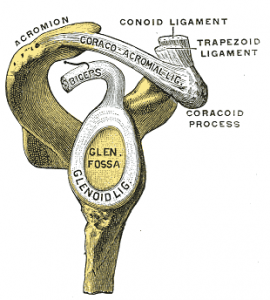Prolotherapy vs. SLAP Lesion

“Gray328”. Licensed under Public Domain via Wikimedia Commons – http://commons.wikimedia.org/wiki/File:Gray328.png#mediaviewer/File:Gray328.png
SLAP lesions or SLAP tears are a someone common cause of shoulder pain. At least that is what the MRI tells us. We see it all the time.
The shoulder is the most frequently injected area (with prolotherapy) in our clinic. One reason is that the shoulder is somewhat commonly injured due to its structure. You can read more about the shoulder anatomy on our Prolotherapy for Rotator Cuff Injury post.
The typical course is that you start to get shoulder pain either from an injury or it just starts hurting for no apparent reason. You go to your doctor and get physical therapy, steroid injections, NSAIDs (anti-inflammatory medications), etc. These things sometimes help and that may be all you need.
But many people aren’t so fortunate. These people are often referred for an MRI and to the orthopedic surgeon. They find a SLAP lesion on your MRI and recommend surgery.
What is a SLAP lesion?
SLAP stands for Superior Labrum tear from Anterior to Posterior. You can see from the image above the ‘Glenoid Lig.’ This is actually the labrum. It is the cartilage in the shoulder which is somewhat analogous with the meniscus in the knee. You’ll also notice something coming off the top of it in that picture.
The structure coming off the top is the long head of the bicep. When the stress on the tendon exceeds its capability then something has to give.
There are several ‘sub-types’ of SLAP lesions depending on the specific location of the injury.
What can you do for a SLAP tear?
You have a few options for what you can do about your SLAP lesion. Traditional approaches involve physical therapy and/or surgery. Wikipedia states “Few with SLAP lesion injuries return to full capability without surgical intervention. In some, physical therapy can strengthen the supporting muscles in the shoulder joint to the point of reestablishing stability. For most others, the choice is to do nothing or some form of surgical repair.”
But when you overlay the information about the success of MRI in identifying these lesions we should certainly consider other options.
Prolotherapy for SLAP tears:
The goals of prolotherapy are to decrease pain and improve functionality. Prolotherapy is VERY good at doing that. There are no studies proving that Prolotherapy ‘cures’ SLAP lesions. In my opinion, there is no reason to do that study.
Why? Well, do you care if your MRI is ‘abnormal’ if you have full function, strength, and range of motion and you don’t have any pain?
Prolotherapy stimulates the body’s natural healing mechanisms and has a very high success rate for dramatically improving the pain and decreased functionality associated with SLAP lesions.
We have treated numerous patients with shoulder pain and MRI diagnosed SLAP tears with excellent results. We have returned numerous athletes to their game in record time without any down time. Several college athletes were able to keep their scholarship because of prolotherapy. They assured me that they were going to lose it if we couldn’t help them.
If you have been diagnosed with a SLAP tear or you have shoulder pain then you should be evaluated for prolotherapy by a qualified and trained prolotherapist.
Call our clinic today to schedule your appointment.
Read what our patients have to say:
- http://www.ncbi.nlm.nih.gov/pubmed/14567906
- http://www.ncbi.nlm.nih.gov/pubmed/25294682






